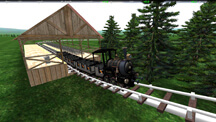
| RELATED WEB SITE |
| * Roller Coaster Dynamics course |
| RELATED LINK |
| * Video of student Jacob Miller's roller-coaster design |

December 3, 2009
Students get engineering thrills in roller-coaster design course
WEST LAFAYETTE, Ind. - |
"What we found was that if you show students the fun engineering applications of physics, all of a sudden learning the fundamentals becomes more enjoyable," said Jeffrey Rhoads, an assistant professor of mechanical engineering.
He and mechanical engineering professor Charles Krousgrill, who together started the roller- coaster dynamics course this year, said the approach has been shown to draw in students who ordinarily might be turned off to engineering.
"It's like we've tapped a passion early in their academic careers using a non-traditional teaching approach to get them into the engineering mindset quicker," Krousgrill said. "So you might be able to break through to students who might not thrive under traditional methods."
The 11 student teams in the course will present their roller coaster designs Wednesday (Dec. 9) and show true-to-life animations demonstrating their creations in action.
"It's not unusual in this class for the majority of students to stay after class for 15 to 20 minutes talking about what was discussed that day," Krousgrill said. "In a typical engineering class, when the class is dismissed there is a stampede towards the door."
He and Rhoads thought of creating the course while teaching another class called dynamics, which involves applying the principles of physics to mechanical systems.
"One of the students in that class was a real whiz on roller coasters," Rhoads said. "He displayed some of his work on roller coasters on the course blog, and he inspired us to start the roller coaster course."
The student, Jacob Miller, a junior in mechanical engineering from Toledo, Ohio, said he liked the new class because it explored complex engineering concepts without boring students.
"It's easy to lose interest in a problem of a technical nature if the application is not immediately obvious," Miller said. "In designing roller coasters, for example, you want the acceleration to be thrilling but not so great that people black out. You want the forces to be exhilarating, but not vertebrae-rearranging, and that made it much more realistic to me."
Even though about half of the students in the class lacked the usual prerequisite, basic mechanics II, the students did well, Rhoads said.
"Honors courses are usually limited to students with a GPA of at least 3.6, but because we had a tremendous response from students interested in taking the course, we decided to relax those requirements," he said.
Rhoads and Krousgrill were concerned that loosening the prerequisite and GPA requirements might spell disaster and lead to many students dropping out, but just the opposite happened. Because the students had already mastered basic physics, they were able to understand the material.
The 22 undergraduate students in the class were split into the 11 teams.
"The idea was to pair a student who had taken more prerequisites with a student who had less experience," Krousgrill said. "This was a real success. They worked together well, and students learned from each other."
The course provides an edge for students seeking internships or jobs with companies that design and manufacture amusement park rides.
"Coursework includes designing roller coasters from scratch and also using a computational software that enables students to worry less about mathematics and more about creative design," Rhoads said. "If they went out and got an internship or a job in this field, they would likely use software of this type."
The course also dovetails with Purdue's prominence in engineering fields related to creative and imaginative engineering.
"Purdue has a very well-defined history in dynamics and vibrations areas that are relevant to the design of these rides," Rhoads said. "Our graduates have had good success getting jobs at companies that design and manufacture amusement park rides, so this course helps to further establish Purdue as the place for creative and fun engineering."
Writer: Emil Venere, 765-494-4709, venere@purdue.edu
Sources: Jeffrey Rhoads, 765-494-5630, jfrhoads@purdue.edu
Charles Krousgrill, 765-494-5738, krousgri@purdue.edu
Jacob Miller, mille411@purdue.edu
Purdue News Service: (765) 494-2096; purduenews@purdue.edu
PHOTO CAPTION:
This still was taken from an animation created in a new roller-coaster-design course at Purdue. The course showed that students are more motivated to learn difficult engineering problems when focusing on a fun application. (Purdue University photo/Jacob Miller)
A publication-quality image is available at https://www.purdue.edu/uns/images/+2009/rhoads-rollercoasters.jpg
Note to Journalists: The students will show their roller coaster designs and animations during a two-hour presentation beginning at 4:30 p.m. Wednesday (Dec. 9) in the Mechanical Engineering Building, Room 116. A video of one of Jacob Miller's designs can be viewed at https://www.youtube.com/watch?v=W4zlAvHDA8U
To the News Service home page
If you have trouble accessing this page because of a disability, please contact Purdue News Service at purduenews@purdue.edu.
